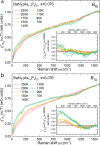An electronic nematic liquid in BaNi2As2
- PMID: 35927267
- PMCID: PMC9352674
- DOI: 10.1038/s41467-022-32112-7
An electronic nematic liquid in BaNi2As2
Abstract
Understanding the organizing principles of interacting electrons and the emergence of novel electronic phases is a central endeavor of condensed matter physics. Electronic nematicity, in which the discrete rotational symmetry in the electron fluid is broken while the translational one remains unaffected, is a prominent example of such a phase. It has proven ubiquitous in correlated electron systems, and is of prime importance to understand Fe-based superconductors. Here, we find that fluctuations of such broken symmetry are exceptionally strong over an extended temperature range above phase transitions in [Formula: see text], the nickel homologue to the Fe-based systems. This lends support to a type of electronic nematicity, dynamical in nature, which exhibits a particularly strong coupling to the underlying crystal lattice. Fluctuations between degenerate nematic configurations cause splitting of phonon lines, without lifting degeneracies nor breaking symmetries, akin to spin liquids in magnetic systems.
© 2022. The Author(s).
Conflict of interest statement
The authors declare no competing interests.
Figures





References
-
- Fernandes RM, Orth PP, Schmalian J. Intertwined vestigial order in quantum materials: nematicity and beyond. Annu. Rev. Condens. Matter Phys. 2019;10:133–154. doi: 10.1146/annurev-conmatphys-031218-013200. - DOI
-
- Böhmer AE, Meingast C. Electronic nematic susceptibility of iron-based superconductors. C. R. Physique. 2016;17:90–112. doi: 10.1016/j.crhy.2015.07.001. - DOI
-
- Chu J-H, Analytis JG, Kucharczyk C, Fisher IR. Determination of the phase diagram of the electron-doped superconductor Ba(Fe1−xCox)2As2. Phys. Rev. B. 2009;79:014506–014506. doi: 10.1103/PhysRevB.79.014506. - DOI
-
- Weber F, et al. Soft phonons reveal the nematic correlation length in . Phys. Rev. B. 2018;98:014516. doi: 10.1103/PhysRevB.98.014516. - DOI
Grants and funding
- 422213477/Deutsche Forschungsgemeinschaft (German Research Foundation)
- 441231589/Deutsche Forschungsgemeinschaft (German Research Foundation)
- 422213477/Deutsche Forschungsgemeinschaft (German Research Foundation)
- 422213477/Deutsche Forschungsgemeinschaft (German Research Foundation)
- 422213477/Deutsche Forschungsgemeinschaft (German Research Foundation)
LinkOut - more resources
Full Text Sources
Research Materials

